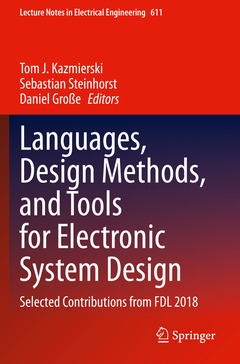Description
Languages, Design Methods, and Tools for Electronic System Design, 1st ed. 2020
Selected Contributions from FDL 2018
Lecture Notes in Electrical Engineering Series, Vol. 611
Coordinators: Kazmierski Tom J., Steinhorst Sebastian, Große Daniel
Language: English
Subjects for Languages, Design Methods, and Tools for Electronic...:
Publication date: 01-2021
192 p. · 15.5x23.5 cm · Paperback
Publication date: 12-2019
192 p. · 15.5x23.5 cm · Hardback
Description
/li>Contents
/li>Biography
/li>Comment
/li>
This book brings together a selection of the best papers from the twenty-first edition of the Forum on specification and Design Languages Conference (FDL), which took place on September 10-12, 2018, in Munich, Germany. FDL is a well-established international forum devoted to dissemination of research results, practical experiences and new ideas in the application of specification, design and verification languages to the design, modeling and verification of integrated circuits, complex hardware/software embedded systems, and mixed-technology systems.
- Covers Assertion Based Design, Verification & Debug;
- Includes language-based modeling and design techniques for embedded systems;
- Covers design, modeling and verification of mixed physical domain and mixed signal systems that include significant analog parts in electrical and non-electrical domains;
- Includes formal and semi-formal system level design methods for complex embeddedsystems based on the Unified Modelling Language (UML) and Model Driven Engineering (MDE).
Introduction.- Automatic Generation of Cycle-Accurate Simulink Blocks from HDL IPs.- Towards Early Validation of Firmware-Based Power Management Using Virtual Prototypes: A Constrained Random Approach.- Symbolic Simulation of Dataflow Synchronous Programs with Timers.- Language and Hardware Acceleration Backend for Graph Processing.- Runtime Task Mapping for Lifetime Budgeting in Many-Core Systems.- Fault Analysis in Analog Circuits through Language Manipulation and Abstraction.- Towards Consistency Checking Between HDL and UPF Descriptions.
The research of Sebastian Steinhorst (b. 1980) centers around design methodology and the hardware/software co-design of distributed embedded systems for use in Internet of Things, smart energy and automotive applications. Key aspects are the architecture, modelling, verification, efficiency,




